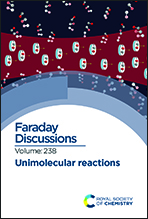Quantum resonances and roaming dynamics in formaldehyde photodissociation†
Abstract
The unimolecular dissociation of formaldehyde is studied via excitation to the à band at several excitation energies from just below the ground state radical dissociation threshold to 5000 cm−1 above it. CO product rotational distributions, photofragment excitation spectroscopy and state-correlated slice imaging results are combined with quasi-classical trajectory calculations to reveal manifestations of quantum effects in this complex dissociation process involving interactions among radical, molecular, and roaming pathways. Evidence of nodal structure at the tight transition state to molecular products is investigated and correlations between the CO rotational and H2 vibrational distributions are used to suggest the transition state modes that are responsible. A large modulation of the roaming yield previously identified and associated with roaming resonances at the onset of the H + HCO(v1,v2,v3 = 0,0,0) product channel suggests a similar origin for enhanced roaming and a roaming yield that is strongly dependent on parent rotation on the 2641 band just 15 cm−1 above the H + HCO(0,2,1) threshold. Similar resonances are predicted on other bands that share near coincident energies with HCO product vibrational thresholds.

- This article is part of the themed collection: Unimolecular reactions


 Please wait while we load your content...
Please wait while we load your content...